10 Best Persuasive Techniques for Sales and Marketing [2022]
Melissa Williams
There are two types of persuasive techniques.
One pushes people into a hole until they have no choice but to fall into it
The other uses rationality. You emphasize how hard things are outside of the hole and the benefits of what’s inside it.
Persuasive techniques are all about creating perceived value.
Perceived value is the worth of a product or service in the mind of a consumer.
Below are 10 techniques that use persuasion to create perceived value and increase readiness to buy.
1. Reframing
Reframe your prospect’s mindset. It’s the classic half-glass of water game. You need to show your prospect it’s full.
How to do it: Take a piece of information someone can’t argue with being true, and use it to adjust their view.
This is one of the best ways to overcome your prospect’s sales objections. If someone uses a competitor, position your offering as complementary or unique.
The email exchange below shows the unique angle. First, there was this objection from The Bridge Group:
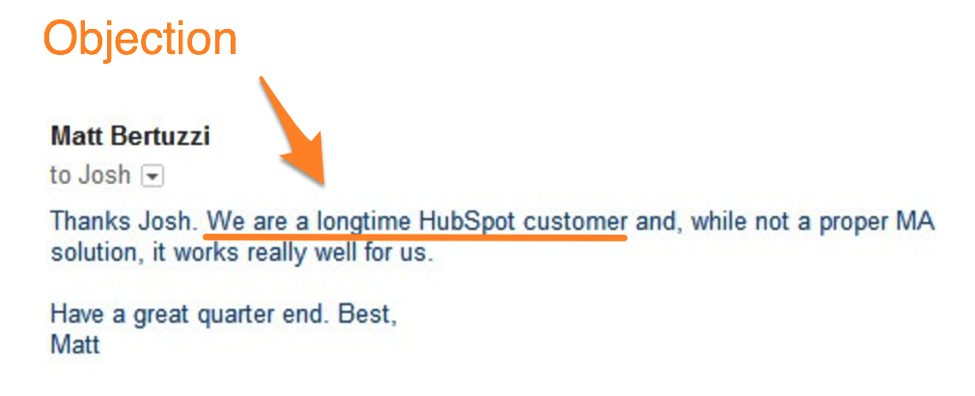
Then, the persuasive reframe:
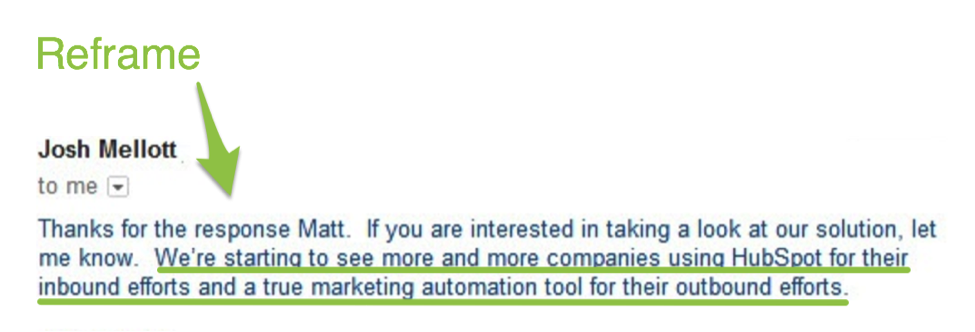
Matt, the prospect, posted this tip-of-the-hat response on his company blog:
.
This shows us that you can actively change someone’s viewpoint in 24 words.
Or 15 words. Like with this statement:
When you’re considering Yesware for $12/month: That’s the cost of one drink at a bar.
Or even 10 words:
When you feel lazy, think: your heart beats 4,800 times/hour.
2. Storytelling
Storytelling breathes life into ordinary marketing. A team gathers in a lab led by neuroeconomist Paul Zak. They’re focused, ready. Poised over a hunch that our brains react to stories, they are hungry to prove it.
And they do.
They draw blood from participants before and after watching a story with a clear climax and close. Amazingly, viewers have higher levels of a trust hormone afterward. Called “oxytocin,” this hormone promotes feelings of connection and empathy.
What’s more, when participants in a different study received synthetic oxytocin up the nose, they donated 57% more to charity than those who received a placebo.
The good news: You can get the people you’re talking with to make oxytocin on their own in their brain by telling them a story.
Here’s how to use storytelling as a persuasive advertising technique:
- Identify a clear climax and close to help your target audience follow the story about your product or service.
- Keep your story in the present tense, so the action is now — not in the past or future.
- Find an emotional piece to what your argument surrounds, and use it as your persuasion technique to entice your customer.
3. Repetition
This persuasive technique helps your target customer become more familiar with your brand. When repeated, words can help you change someone’s mind.
In an experiment of 100 participants, repeating selective information changed opinions.
Students first decided which of two job applicants were better qualified. They were given equal positive and negative attributes to help decide.
Then, they were paired face-to-face with someone who repeated information supporting the opposite candidate. When asked to decide again, 70% of students revised their decision.
“From a rational point of view, information repetitions constitute redundancy and, hence, should not affect the recipient’s decision,” the researchers write. “By contrast, in two experiments we demonstrate that selectively repeating information in favor of a particular decision alternative changes preference ratings in favor of this alternative and makes a decision for this alternative more likely.”
Do it on your own: When you’re writing an email, repeat the main point in your subject line, opening, and final note.
Here’s an example (get the template here — see section #2):
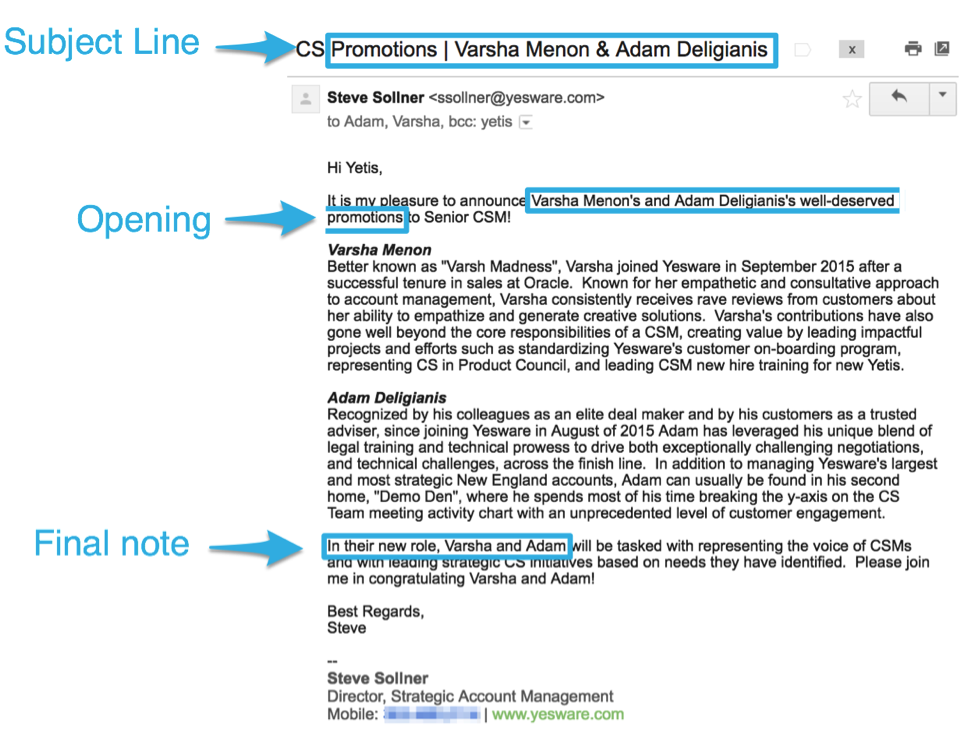
4. Specificity
Specificity makes a persuasive strategy more believable.
Read the following:
Repeating information changes opinions.
Now read this alternative pulled from the section above:
In an experiment of 100 participants, repeating selective information changed opinions.
Which version makes you more confident about the effect of information on opinions?
Behold, the power of specificity as a persuasive strategy. Here’s how Copyblogger explains it:
Precise details help convey that you are telling the truth. A vague “guesstimate” is not going to have the same impact because a nagging doubt clouds the prospect’s mind. Without other concrete facts they might think that you are just making the whole thing up, or at least exaggerating.
Do it on your own: If you’re sending someone a case study, make sure it has a quantifiable measure of success in it. Pull that number into the descriptive text that you hyperlink.
See an example here — it’s #15 — plus 17 other A/B testing email ideas.
Tip: Grab 13 power words that are proven to persuade and convert.
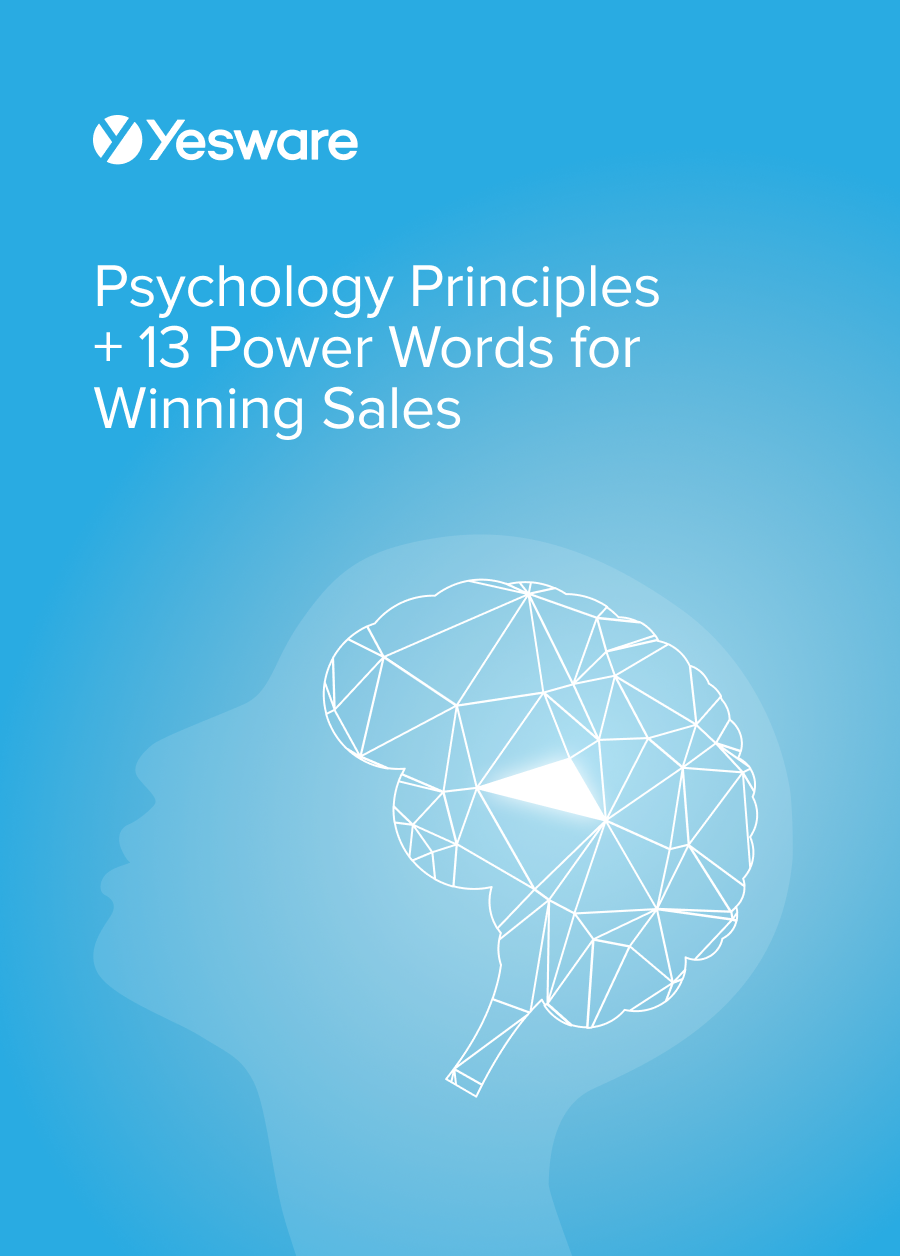 Psychology Principles + 13 Power Words for Winning SalesData-backed psychological principles, nonverbal cues, and persuasive phrases to win more deals.
Psychology Principles + 13 Power Words for Winning SalesData-backed psychological principles, nonverbal cues, and persuasive phrases to win more deals.
5. Authenticity
Authenticity attracts trust. We know we trust people who are real with us, but consumers make the same decisions about brands.
Check out this example of an authentic persuasive technique in advertising:
A watch company ran an A/B test on their site. Do you see that text in purple below? They wanted to find out how it affected watch purchases. Over a 30-day experiment, the variation without the slogan “never beaten on price” saw a 107% increase in conversions.
The lesson: Don’t make bold claims — especially without third-party proof to back you up.
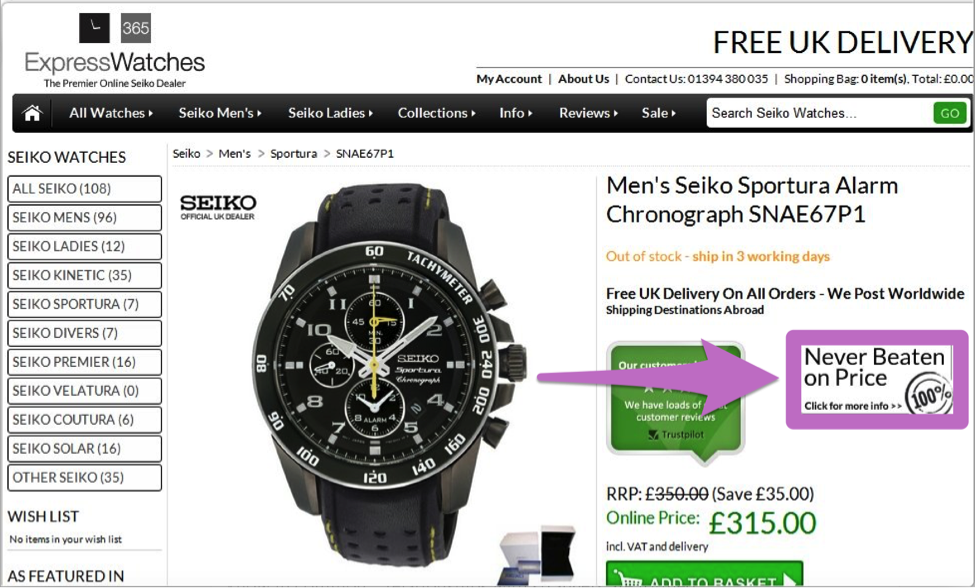
People know when you’re bullshitting them. This is why the phrase “exclusive invitation” in email subject lines to webinar invites gets 69% fewer opens than average.
Takeaway: Honesty is key. Don’t make hyperboles that are fluff; stick to backable descriptions of who you and/or what your company does.
6. Social Proof
Social proof increases willingness to buy. Instead of using hyperbole or tooting your own horn, let your customers do it for you.
It’s easier, and it’s more effective. We trust our peers most.
Think about canned laughter.
Sitcoms build it in because they know it makes viewers laugh harder themselves.
We base our judgments on other people’s. This is also why customer names and testimonials from people similar to us are great marketing techniques and make us more likely to buy.
That’s the power of social proof.

How to do it: If you’re writing a sales email, mention three recognizable company names that you serve. Or include a quote from a customer in a similar role to your email recipient.
Tip: Sales proposal template and tips here.
7. Reasoning
Telling them “why” makes their decision easy. You know how little kids love to ask “why”?
Well, we have this same craving as adults, and the word “because” gives us a suitable answer.
It’s not a rhetorical question — it gets us to take action.
One of the most interesting examples of this is a psychological study held at a photocopier.
People in line to photocopy were asked three variations of the same request to cut:
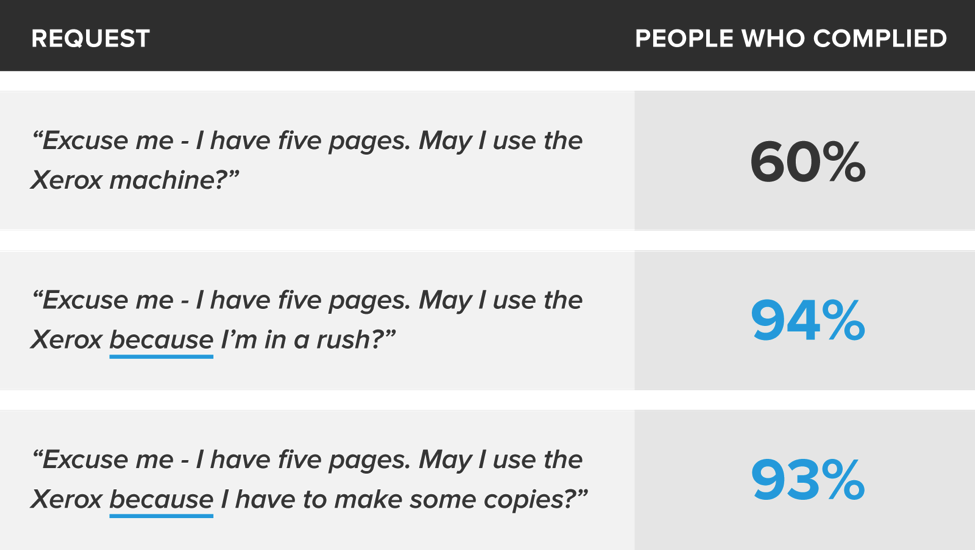
What’s so intriguing is that 93% of people comply when the experimenter has the same reason as anyone else.
That’s how powerful the word “because” is in driving action.
How to use it in an email: Use this formal email template (scroll to the first template)
8. Metaphoring
Another persuasive technique is using metaphors to make prospects process faster and stay engaged. Science shows that when we hear metaphors, we live them out in our brain.
The act of hearing a textural metaphor lights up brain scans like wildfire.
Benjamin Bergen, a researcher at the University of California, San Diego explains why:
The way that you understand an action is by recreating in your vision system what it would look like to perceive that event and recreating in your motor system what it would be like.” (source: NPR.org)
If you want to sell a target customer your product or service, make it tangible for them.
- Identify a pain point
- Think of how it can be textural
- Include it in your email as the first part of a BAB or PAS formula
Here’s an example of a textural pain point:
“Tired of grasping at straws that break in your hands?”
9. Shared Commonalities
Identifying shared commonality creates trust. We like, trust, and listen to people who are similar to us.
Commonalities create fast friendships, but you can also use them to create persuasion.
Bonding with a target customer with a unique similarity to us helps us fit in and stand out — two things humans crave.
Life is full of finding shortcuts, and this is how the Similarity Principle works. We jump to assuming that someone’s similarity makes them as trustworthy as we are. The alternative: taking the time and effort to decide bit by bit whether this person is honest and reliable.
DIY: Take a minute to research your prospect and then add it into an email like this:
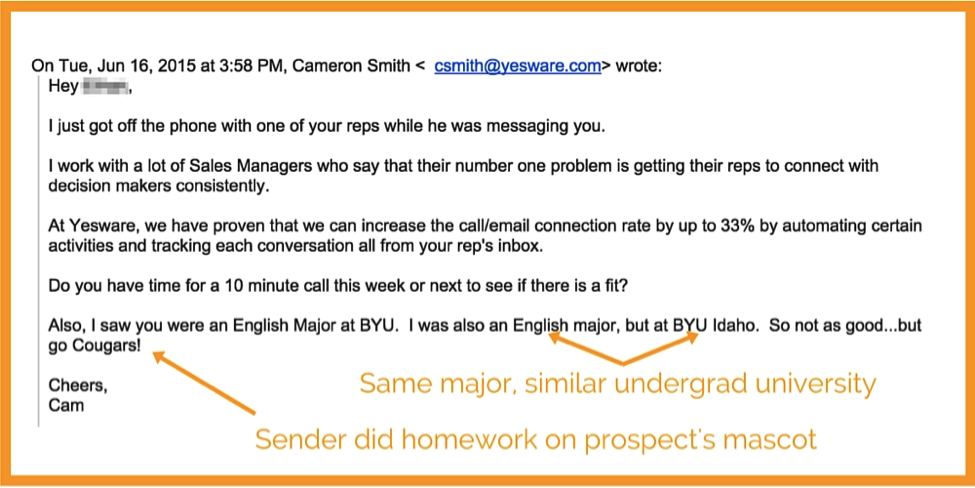
10. Authority
Emphasizing that they’re in control increases persuasion. Everyone’s a little bit of a control freak when it comes down to it.
We don’t want someone to tell us what to do — especially if we don’t agree with it.
Science proves that removing the pressure in an offer makes us 2 times more likely to say yes. This is why we do things like volunteer and donate.
It’s called the But You Are Free (BYAF) technique.
Rhetorical phrases that do the trick (and keep it conversational) :
“No pressure”
“It’s up to you”
“Whatever you prefer”
“If you’d like”
Persuading your Customer Starts with Your Sales Strategy
- Who you’re writing to (What their values are & What their current situation is)
- What action you want them to take
The better you are at creating perceived value, the higher you can bump your market price and reduce consumer surplus. This doesn’t mean selling something that turns out to be smoke and mirrors. It means selling an expectation that matches reality.
You take latent needs and wants and surface them, adding immediacy with persuasive techniques. Ready to get started?
Yesware can help with this by saving your top-performing persuasive techniques as templates for re-use, then measuring the effectiveness of all your emails so you know what is/isn’t working.
Originally published July 19, 2017, updated November 15, 2022.
Get sales tips and strategies delivered straight to your inbox.
Yesware will help you generate more sales right from your inbox. Try our Outlook add-on or Gmail Chrome extension for free, forever!
Related Articles
Melissa Williams
Melissa Williams
Casey O'Connor
Sales, deal management, and communication tips for your inbox
![10 Best Persuasive Techniques for Sales and Marketing [2022]](/blog/_next/image/?url=https%3A%2F%2Fwww.yesware.com%2Fwp-content%2Fuploads%2F2021%2F07%2Fyesware-persuasive-techniques.jpg&w=1984&q=75)
